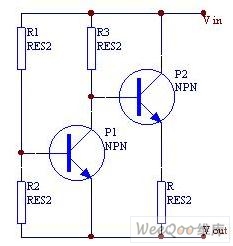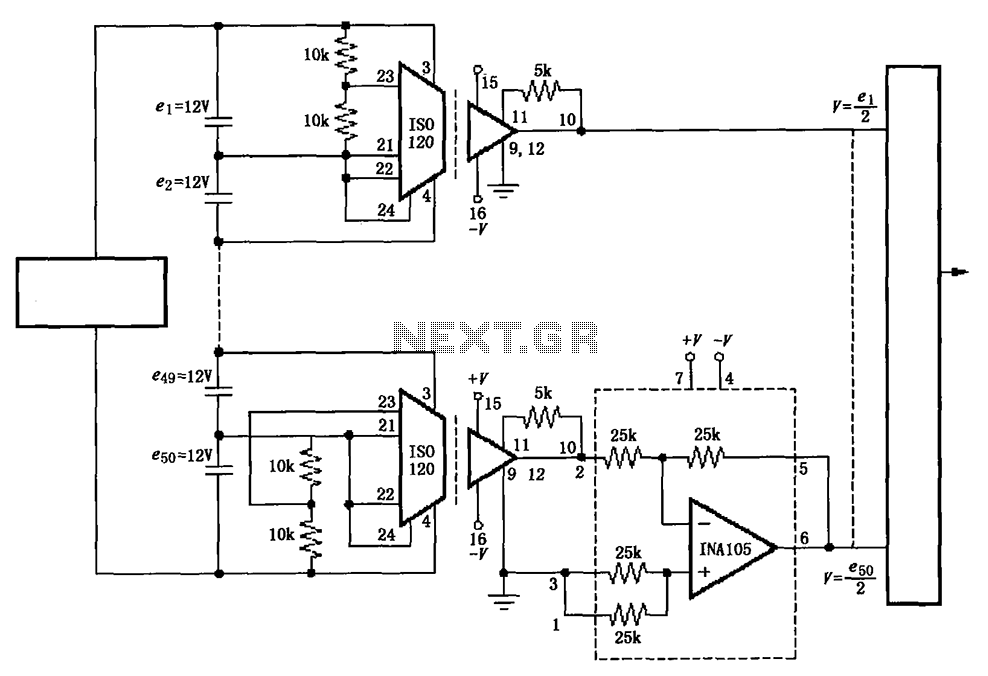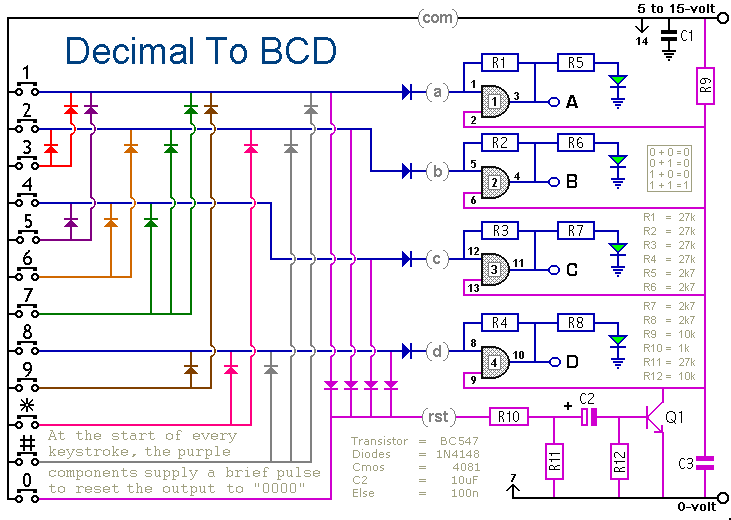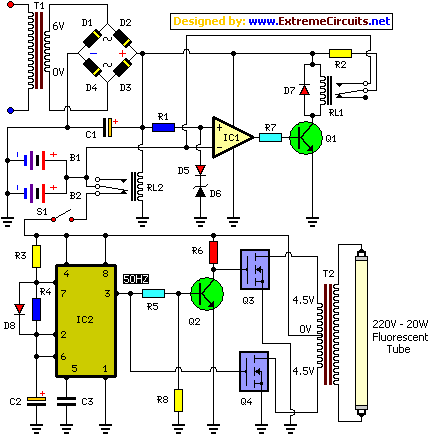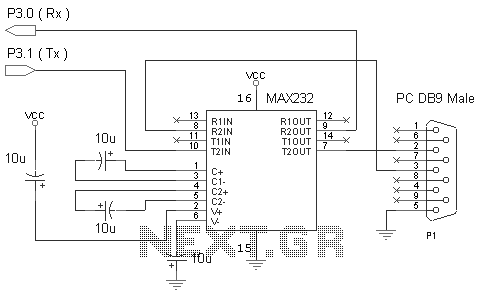
Subwoofer Filter Circuit
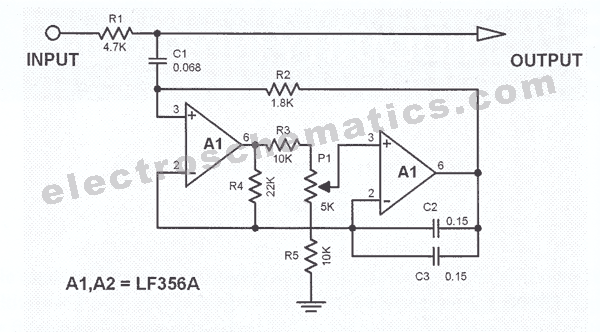
This active subwoofer filter circuit is a 24 dB per octave filter with a Bessel characteristic and a cutoff frequency of 200 Hz. It is suitable for those experimenting with audio circuits in the subwoofer range, as all audio frequencies below 200 Hz can be directed to a single speaker box. This is due to the diminished human ability to perceive directionality in sound at these lower frequencies. Normal stereo signals above 200 Hz can be sent to two satellite speakers. The subwoofer filter operates with A1 and A2 buffering the signals from the right and left channels. The op-amp combinations A2/A4 and A9/A10 serve as high-pass filters, with their outputs connected to the final amplifiers of the satellite boxes. Signals from both channels are routed to A5, while op-amps A6/A7 function as the low-pass filter, and A8 acts as the output amplifier for the subwoofer signal. The signal levels can be balanced between the subwoofer and the satellite lines. A symmetrical power supply is required for this filter circuit, and the op-amps can feature either JFET or bipolar inputs. The circuit is utilized in DTS cinema surround systems in various theaters and in a 5.2 channel Dolby Digital 3D Holophonic surround system. Pin assignments are as follows: Pin 1 is the output of OP1, Pin 2 is the inverting input of OP1, Pin 3 is the non-inverting input of OP1, Pin 4 is VEE (the most negative supply ground, which can be generated using two resistors and an electrolytic capacitor), Pin 5 is the non-inverting input of OP2, Pin 6 is the inverting input of OP2, Pin 7 is the output of OP2, and Pin 8 is VCC (the most positive supply). The LM833 can operate at 30VDC, while the TLMC662 operates at 12VDC with CMOS inputs, allowing it to swing closer to its rails. The LME49726 operates at 5V with exceptionally low distortion, making it challenging for commercial distortion analyzers to read accurately (VOUT = 3.5V P-P, VDD = 5.0V, THD = 0.00008%). The upper and lower sections of the circuit are high-pass filters set around 200 Hz, and the frequency can be adjusted by changing capacitors (C2, C3, C4, C5, C13, C14, C15, C16). Doubling the capacitor value halves the frequency, while halving the capacitor value doubles the passband. In the middle section, the low-pass filter frequency can be adjusted by changing resistors (R9, R10, R11, R12), following the same principles. A web-based calculator for these filters is recommended for further assistance. The differences in resistor values for each stage of the high-pass filter and the different capacitor values for each stage of the low-pass filter are noted. An active filter like this is essentially an RC filter with feedback, allowing the impedance of previous components to have minimal effect. This enhances the effectiveness of the RC filter sections, resulting in a sharper roll-off at the desired frequency. The quality factor (Q) of the filter indicates how sharp the roll-off is. For high-pass filters, varying resistor values allows for adjustments in both Q and frequency, while for low-pass filters, capacitor values are adjusted similarly. Each section should either use the same resistor values or the same capacitor values. A simple RC filter typically has a roll-off of 6 dB per octave, calculated as f6db = 1/(2πRC) (with R in ohms, C in farads, and f in Hertz). To achieve better than 6 dB per octave, an active filter is employed, allowing for Q adjustments up to 15 dB per octave.
The active subwoofer filter circuit is designed to effectively manage audio signals, particularly in home theater and professional audio applications. The circuit's architecture, featuring multiple op-amps, enables precise control over the audio frequency response, ensuring optimal performance for subwoofers and satellite speakers. Each op-amp stage is carefully selected to provide the desired filtering characteristics, with Bessel filters chosen for their phase response, which is critical in maintaining audio clarity and coherence in multi-speaker setups.
The symmetrical power supply requirement ensures stable operation across the circuit, minimizing noise and distortion. The choice of op-amps, including the LM833, TLMC662, and LME49726, reflects a balance between performance and operational voltage, allowing flexibility in various applications. The ability to adjust component values for both high-pass and low-pass sections provides users with the tools necessary to fine-tune the filter's response to suit specific acoustic environments or personal preferences.
In practical implementation, the circuit can be integrated into existing audio systems with minimal modification, making it a versatile solution for enhancing low-frequency audio reproduction. The detailed pin configuration and operational guidelines ensure ease of use for engineers and hobbyists alike, facilitating straightforward assembly and troubleshooting. Overall, this active filter circuit exemplifies a sophisticated approach to audio signal processing, catering to the nuanced demands of modern audio systems.This subwoofer active filter circuit is a 24 dB octave filter with a Bessel character and cutoff frequency of 200 Hz. So, if you are interested in experimenting with audio circuits in subwoofer range, this circuit is for you.
In subwoofer range, all audio frequencies below 200 Hz can be fed to a single speaker box since the human directional perce ption of sound diminishes at this frequency range. The normal stereo signals above 200 Hz can be fed to 2 satellite speakers. How does the subwoofer filter works: A1 and A2 buffer the signals coming from right and left channels. Opamp combinations A2/A4 and A9/A10 function as the highpass filters. The outputs are then connected to the final amplifiers of the battelite boxes. Signals from both channels are fed to A5. Opamps A6/A7 function as the lowpassfilter, A8 as the output amplifier for the subwoofer signal. The signal level can be balanced between the subwoofer and the satellite lines. The power needed for this filter circuit must ne a symmetrical power supply. The opamps can have either JFET or bipolar inputs. super circit. I use this circuits in DTS cinema surround system in many theatres. Also i use it in my 5. 2 ch DOLBY DIGITAL 3D hOLOPHONIC SURROUND SYSTEM . Pin 1 is OP 1 output. Pin 2 is OP 1 inverting input. Pin 3 is OP 1 non-inverting input. Pin 4 is VEE (most negative supply ground can be used, but the virtual ground must be generated using two resistors and an electrolytic capacitor).
Pin 5 is OP 2 non-inverting input. Pin 6 is OP 2 inverting input. Pin 7 is OP 2 output. Pin 8 is VCC (most positive supply). The LM833 is capable of 30VDC operation. The TLMC662 is capable of 12VDC operation, but has CMOS inputs and can swing closer to its rails. The LME49726 operates on 5V, buhas such low distortion commercial distortion analyzers have trouble reading it (VOUT = 3. 5VP-P, VDD = 5. 0V, THD = 0. 00008%). The upper and lower sections are high pass circuits and they are set for about 200Hz. Changing the capacitors (C2, 3, 4, 5, 13, 14, 15, 16) is the easiest way to adjust the frequncy for those.
Just make sure all capacitor values are the same. Double the value and you will halve the frequency. Cut the value in half and you will double the pass band. For the middle section, a low pass filter, adjusting the resistors (R9, 10, 11, 12) changes the frequency. The same rule applies. Keep all resistance values the same and increase to lower the pass band frequency and reduce the resistance to raise the frequency.
The web page has a great calculator for these filters. Thanks for the link. I still don`t understand the different values of resistors on each stage of the high pass filter and the different values of cap on each stage of the low pass. An active filter like this is just an RC filter with a way of feeding back some of the signal in a way that the impedence of the previous components can`t affect.
This can help make the RC filter sections (you can see both kinds of stages are made with 2 resistors and 2 capacitors) more effective and the roloff at the chosen frequency sharper. This is where the filters Q comes into it. This is basically a measure of how sharp the filters roloff is. For each kind of filter, either the resistive or capacitive elements have a larger effect on the Q of the filter (yes, the Q stands for quality).
For high pass filters, the different resistor values allow one to adjust the Q as well as setting the frequency. For low pass filters, the capacitors do this. Thus, each section either uses all the same resistor values or all the same capacitor values. A simple RC filter has a 6db per octave value calculated from f6db=1/2*pi*R*C (with R in ohms and C in farads and f in Hertz).
To get better than 6db per octave, you would use an active filter and be able to adjust the Q for 15db per octave. As I tried to explain, these are not simple RC filters with 6db per octave rolloff. By using a buffe 🔗 External reference
The active subwoofer filter circuit is designed to effectively manage audio signals, particularly in home theater and professional audio applications. The circuit's architecture, featuring multiple op-amps, enables precise control over the audio frequency response, ensuring optimal performance for subwoofers and satellite speakers. Each op-amp stage is carefully selected to provide the desired filtering characteristics, with Bessel filters chosen for their phase response, which is critical in maintaining audio clarity and coherence in multi-speaker setups.
The symmetrical power supply requirement ensures stable operation across the circuit, minimizing noise and distortion. The choice of op-amps, including the LM833, TLMC662, and LME49726, reflects a balance between performance and operational voltage, allowing flexibility in various applications. The ability to adjust component values for both high-pass and low-pass sections provides users with the tools necessary to fine-tune the filter's response to suit specific acoustic environments or personal preferences.
In practical implementation, the circuit can be integrated into existing audio systems with minimal modification, making it a versatile solution for enhancing low-frequency audio reproduction. The detailed pin configuration and operational guidelines ensure ease of use for engineers and hobbyists alike, facilitating straightforward assembly and troubleshooting. Overall, this active filter circuit exemplifies a sophisticated approach to audio signal processing, catering to the nuanced demands of modern audio systems.This subwoofer active filter circuit is a 24 dB octave filter with a Bessel character and cutoff frequency of 200 Hz. So, if you are interested in experimenting with audio circuits in subwoofer range, this circuit is for you.
In subwoofer range, all audio frequencies below 200 Hz can be fed to a single speaker box since the human directional perce ption of sound diminishes at this frequency range. The normal stereo signals above 200 Hz can be fed to 2 satellite speakers. How does the subwoofer filter works: A1 and A2 buffer the signals coming from right and left channels. Opamp combinations A2/A4 and A9/A10 function as the highpass filters. The outputs are then connected to the final amplifiers of the battelite boxes. Signals from both channels are fed to A5. Opamps A6/A7 function as the lowpassfilter, A8 as the output amplifier for the subwoofer signal. The signal level can be balanced between the subwoofer and the satellite lines. The power needed for this filter circuit must ne a symmetrical power supply. The opamps can have either JFET or bipolar inputs. super circit. I use this circuits in DTS cinema surround system in many theatres. Also i use it in my 5. 2 ch DOLBY DIGITAL 3D hOLOPHONIC SURROUND SYSTEM . Pin 1 is OP 1 output. Pin 2 is OP 1 inverting input. Pin 3 is OP 1 non-inverting input. Pin 4 is VEE (most negative supply ground can be used, but the virtual ground must be generated using two resistors and an electrolytic capacitor).
Pin 5 is OP 2 non-inverting input. Pin 6 is OP 2 inverting input. Pin 7 is OP 2 output. Pin 8 is VCC (most positive supply). The LM833 is capable of 30VDC operation. The TLMC662 is capable of 12VDC operation, but has CMOS inputs and can swing closer to its rails. The LME49726 operates on 5V, buhas such low distortion commercial distortion analyzers have trouble reading it (VOUT = 3. 5VP-P, VDD = 5. 0V, THD = 0. 00008%). The upper and lower sections are high pass circuits and they are set for about 200Hz. Changing the capacitors (C2, 3, 4, 5, 13, 14, 15, 16) is the easiest way to adjust the frequncy for those.
Just make sure all capacitor values are the same. Double the value and you will halve the frequency. Cut the value in half and you will double the pass band. For the middle section, a low pass filter, adjusting the resistors (R9, 10, 11, 12) changes the frequency. The same rule applies. Keep all resistance values the same and increase to lower the pass band frequency and reduce the resistance to raise the frequency.
The web page has a great calculator for these filters. Thanks for the link. I still don`t understand the different values of resistors on each stage of the high pass filter and the different values of cap on each stage of the low pass. An active filter like this is just an RC filter with a way of feeding back some of the signal in a way that the impedence of the previous components can`t affect.
This can help make the RC filter sections (you can see both kinds of stages are made with 2 resistors and 2 capacitors) more effective and the roloff at the chosen frequency sharper. This is where the filters Q comes into it. This is basically a measure of how sharp the filters roloff is. For each kind of filter, either the resistive or capacitive elements have a larger effect on the Q of the filter (yes, the Q stands for quality).
For high pass filters, the different resistor values allow one to adjust the Q as well as setting the frequency. For low pass filters, the capacitors do this. Thus, each section either uses all the same resistor values or all the same capacitor values. A simple RC filter has a 6db per octave value calculated from f6db=1/2*pi*R*C (with R in ohms and C in farads and f in Hertz).
To get better than 6db per octave, you would use an active filter and be able to adjust the Q for 15db per octave. As I tried to explain, these are not simple RC filters with 6db per octave rolloff. By using a buffe 🔗 External reference
